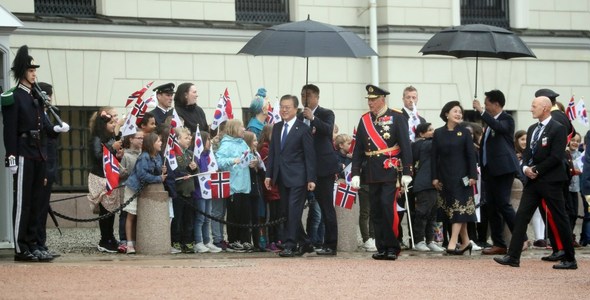 |
|
Artist Kim Seung-hee and curator Kim Keum-hwa at the opening ceremony for the Third Nature project in Berlin’s Kulturforum and Matthaeuskirche on May 23. (Han Joo-yeon, correspondent)
|
Artists of Third Nature project hope to foster atmosphere of inter-Korean reconciliation
“Our project changes in fluid ways with the state of inter-Korean relations. I thought that aspect itself could be an artistic process: the artwork takes on dynamic variables amid the dynamics of politics. Right now, we’re waiting for plants to arrive from North Korea.” A 3D miniature version of the Baekdudaegan mountain range, reminiscent of the landscape painting “After Rain at Mt. Inwang” by artist Jeong Seon (1676–1759, known by the pen name “Gyeomjae”), has been created in Berlin. Part of the “Third Nature” project, the creation has clouds and mist billowing over a mountain of rocks modeled on the Baekdudaegan range in basalt and earth. In the garden, indigenous South and North Korean flora has been planted from across the Korean Peninsula. The opening ceremony on the evening of May 23 attracted major attention, with around 600 exchange students, overseas Koreans, and local residents joining installation artists Han Seok-hyeon, 44, and Kim Seung-hee, 41. Planning and organization were supervised by Kim Keum-hwa, 41, curator of Keum Art Projects. “Pretty soon, the whole thing will be covered in white flowers,” the artists explained on June 8 at the garden, which was created on a site in Berlin’s Kulturforum and Matthaeuskirche. After conceiving of the project three year ago, Kim Keum-hwa’s first stop was the North Korean Embassy in Berlin. “The response from the North was positive. We arranged to receive North Korean flora through the inter-Korean joint liaison office at the Kaesong Industrial Complex,” she explained. “But when they second North Korea-US summit in Hanoi collapsed last February, we were at a loss. We’re still in contact, but we haven’t received a response.” Kim added, “While doing this project, I gained a new sense of what it means to be citizens of a divided country.” “I’d like for there to be progress soon in inter-Korean exchange so that we can have South and North Korean ecologists holding a symposium in this garden to discuss the plants of the Baekdudaegan,” she said. The garden’s setting is surrounded by the Matthaeuskirche (which also serves as a cultural foundation), the Kulturforum’s collection of national art museums, and the Berlin Philharmonic. “This is a cultural center in western Berlin, and it’s close to where the Wall used to be. It was put together by West Germany during the days of division into East and West in order to prove the superiority of its political system. It still draws around 100,000 tourists each year.” It wasn’t easy crafting a garden in this illustrious center of Berlin. The most difficult issue concerned permits. The artists were unable to do everything they had hoped; they had to comply with German standards in the specifications and construction methods and follow the legally stipulated procedures. Once the permit was in hand, Kim Seung-hee was responsible for selecting and transporting the plants. In January, he began bringing them in and transplanting them by way of the Berlin Botanical Garden. Selecting 23 North Korean plants and 37 South Korean ones, he was able to transport 45 seedlings to Berlin. The group also had to cooperate closely with South Korean and German agencies. The Berlin Botanical Garden, the St. Matthew Foundation, and the local parks and art agencies provided major assistance, as the landscaping and installation required the technology and consulting of German experts. “We’re also proud of it being a project achieved together with German agencies,” Kim Keum-hwa said.
 |
|
A recreation of the Baekdudaegan mountain range by installation artists Han Seok-hyeon (left) and Kim Seung-hee (right) as part of the Third Nature project in Berlin. (Han Joo-yeon)
|






